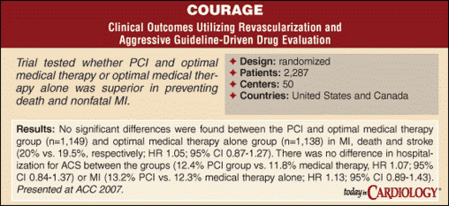COURAGE causes stir over the importance of PCI
In patients with stable CAD, PCI does not provide any benefit when added to OMT.
NEW ORLEANS — The first coronary angioplasty was performed in 1977, for stable coronary artery disease.
“Since that time, interventional cardiology has flourished amidst profound technological advances and continued evolution of more increasingly sophisticated catheter-based approaches,” said William Boden, MD, professor of medicine and public health and medicine at University at Buffalo School of Medicine and Biomedical Sciences. “PCI has become common in the initial management of symptomatic patients with stable CAD in North America even though current treatment guidelines continue to advocate the role of aggressive medical therapy, risk factor reduction and lifestyle intervention.”
Percutaneous coronary intervention is now performed more than 1 million times a year in the United States alone, the majority of which are elective among patients with stable CAD. Salim Yusuf, MD, professor of medicine at McMaster University Faculty of Health Sciences, Hamilton, Ontario, Canada, said the industry has grown to represent $15 to $20 billion a year in North America.
While PCI is known to improve survival when done to restore blood flow in the early hours after acute MI, no study has examined the ability of PCI to improve outcomes above optimal medical therapy (OMT) in patients with stable CAD.
The Clinical Outcomes Utilizing Percutaneous Revascularization and Aggressive Guideline-Driven Drug Evaluation (COURAGE) trial did just that, and prompted experts to question the utility of PCI among stable patients.
“PCI has very little value to offer in such patients,” Yusuf said during a panel discuss following the presentation of COURAGE at the 56th Annual American College of Cardiology Scientific Sessions 2007 here. “It doesn’t affect mortality. It doesn’t affect MI, does not prevent hospitalization for angina or strokes. If anything it may increase the risk of early MI. The COURAGE study is the fourth study to demonstrate that PCI in such patients is ineffective, except for a small impact on angina that is short-lived.”
COURAGE results
Researchers enrolled 2,287 patients at 50 U.S. and Canadian hospitals between June 1999 and January 2004. They randomly assigned patients to either PCI and OMT (n=1,149) or OMT (n=1,138).
Results showed a similar 4.6-year cumulative primary event rate of death, MI or stroke among both populations (19% for PCI and OMT vs. 18.5% for OMT; HR 1.05; 95% CI, 0.87-1.27). There were 211 primary events in the PCI group vs. 202 in the OMT group. Overall survival was similar (7.6% for PCI and OMT vs. 8.3% OMT; HR 0.87; 95% CI, 0.65-1.16); as was survival free of hospitalization for acute coronary syndromes (11.8% OMT vs. 12.4% PCI and OMT; HR 1.07; 95% CI, 0.84-1.37) and survival free of MI (12.3% OMT vs. 13.2% PCI and OMT; HR 1.13; 95% CI 0.89-1.43).
“As initial management strategy in patients with stable coronary artery disease, PCI did not reduce the risk of death, MI or other major cardiovascular events as compared with optimal medical therapy alone,” Boden said. “As expected, PCI resulted in better angina relief during most of the follow-up period but medical therapy was also remarkably effective with no between-group difference in angina-free status at five years.”
Per the health status and economic outcomes of COURAGE, William S. Weintraub, MD, the John H. Ammon Chair of Cardiology and director of the Christiana Center for Outcomes Research, Del., said, “PCI in the setting of stable coronary artery disease does not reduce the incidence of death or MI. Angina will improve with either PCI and OMT or OMT alone.
“Compared to OMT, PCI and OMT as a first choice of therapy for stable CAD is extremely expensive,” he said.

PCI still has a role
Despite Yusuf’s statement that PCI is of little value as initial therapy for people with stable CAD, he said the COURAGE data do not undermine the value of PCI in acute MI.
“That stands,” he said, supporting studies for high-risk patients with unstable angina undergoing revascularization that includes both PCI and CABG.
“Let’s not forget that the group of patients with ST segment elevation MI, with non-ST segment acute coronary syndromes and the high-risk refractory ischemic symptomatic patients continue to benefit from angioplasty. I don’t want that message to be lost,” said panelist Robert A. Harrington, MD, director of the Duke Clinical Research Institute.
“The reason for the extensive use of PCI is not based on scientific proof, nor related to proven medical benefit; instead it is sociological,” he said. “And we all suspect [it] but we don’t want to say it – it is also driven by economic force. It’s really time to confront this because the practice of medicine in this instance has been seriously misguided.”
Embargo broken
In a statement published in the convention newspaper March 27, the ACC said it was “extremely disappointed that this individual or individuals released this information, betraying the confidentiality of the scholarly process and the professional integrity of the scientific community.”
The ACC will consider sanctions, it further read. – by Judith Rusk
For more information:
- Boden WE. A randomized trial of percutaneous coronary intervention added to optimal medical therapy in patients with stable coronary heart disease: Results of the Clinical Outcomes Utilizing Revascularization and Aggressive Guideline-Driven Drug Evaluation (COURAGE) trial.
- Weintraub WS. Quality of life and economic outcomes in the Clinical Outcomes Utilizing Percutaneous Coronary Revascularization and Aggressive Guideline-Driven Drug Evaluation (COURAGE) trial.
- Both presented during late-breaking clinical trials III at: The 56th Annual American College of Cardiology Scientific Sessions; March 25-27, 2007; New Orleans.
